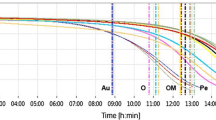Abstract
Effect of cryogenic grinding on volatile oil, oleoresin content, total phenolics, flavonoid content and anti-oxidant properties of seed extract of nine coriander (Coriandrum sativum L.) genotypes have been analyzed. Volatile oil and oleoresin content was significantly high in cryogenically ground samples ranged from 0.14 % in genotype RCr 436 to 0.39 % in genotype Sindhu while oleoresin content was ranged from 13.80 % in ACr 1 to 19.58 % in Australia. Yield of methanol crude seed extract was invariably high in cryo ground samples of all the genotypes and total phenolic content was also high in all the genotypes. It was ranging from a minimum of 32.44 mg in RCr 41 to a maximum of 92.99 mg Gallic Acid Equivalent (GAE)/g crude seed extract in genotype Sindhu. Similarly Total flavanoid content was also increase in all cryogenically ground samples and ranged from 15.28 mg Quercetin Equivalent (QE)/g crude seed extract in genotype Sindhu to 20.85 mg QE/g crude seed extract in genotype Swati. Methanol crude seed extract of all genotypes were evaluated for its antioxidant activity in terms of total antioxidant content, 1, 1-Diphenyl-2-picrylhydrazin (DPPH) free radical scavenging % and EC50 value. The amount of total antioxidant content in cryo ground seeds was significantly high in all genotypes which was ranging from 5.09 mg in genotype Sindhu to 10.85 mg Butyl Hydroxyl Toluene (BHT) Equivalent/g crude seed extract in genotype Sadhna. DPPH scavenging % was invariably more in cryo ground seeds in all the genotypes. Higher concentration of antioxidant content and DPPH scavenging % suggested high antioxidant activity in cryo ground samples. It could be concluded that cryogenic grinding technology is able to retain flavour and antioxidant properties of coriander irrespective of the genotypes.
Similar content being viewed by others
References
Amin I, Norazaidah Y, Hainida KIE (2006) Antioxidant activity and phenolic content of raw and blanched Amaranthus species. Food Chem 94:47–52
Chang C, Yang M, Wen H, Chern J (2002) Estimation of total flavonoid content in propolis by two complementary colorimetric methods. J Food Drug Anal 10:178–182
Chu YH, Chang CL, Hsu HF (2000) Flavonoid content of several vegetables and their antioxidant activity. J Sci Food Agric 80:561–566
Clevenger JF (1928) Apparatus for determination of essential oil. J Am Pharm Assoc 17:346–349
Kaur C, Kapoor HC (2002) Anti-oxidant activity and total phenolic content of some Asian vegetables. Int J Food Sci Technol 37(2):153–161
Landwehr D, Pahl MH (1986) Cold grinding and spices. Int J Food Technol Food Process Eng 37:174–185
Li S, Ge S, Hwang Z, Wang Q, Zhao H, Pan H (1991) Cryogenic grinding technology for traditional Chinese herbal medicines. Cryogenics 31:136–137
Omidbaigi R (2007) Production and processing of medicinal plants. Behnashr Pub, Mashhad, pp 1–347
Parichat B, Artiwan S (2007) Extraction of phenolic compounds from fruits of bitter melon (Momordica charantia) with subcritical water extraction and antioxidant activities of these extracts. Chiang Mai J Sci 35:123–130
Ramezani S, Rahmanian M, Jahanbin R, Mohajeri F, Rezaei RR, Solaimani F (2009) Diuranal changes in essential oil content of coriander (Coriandrum sativum L) aerial parts from Iran. Res J Biol Sci 4(3):277–281
Saxena SN, Meena RS, Panwar A, Saxena R (2010) Assessment of loss of volatile oil in coriander (Coriandrum sativum L.) during conventional grinding. In: National consultation on seed spices biodiversity and production for export-perspective, potential and their solutions held at NRCSS on July 7, 2010 p 74
Shan B, Cai YZ, Sun M, Corke H (2005) Antioxidant capacity of 26 spice extracts and characterization of their phenolic constituents. J Agric Food Chem 53:7749–7759
Shimada K, Fujikawa K, Yahara K, Nakamura T (1992) Antioxidative properties of xanthin on autoxidation of soybean oil in cyclodextrin emulsion. J Agric Food Chem 40:945–948
Singh KK, Goswami TK (1999a) Studies on cryogenic grinding of cumin seed. J Food Process Eng 22:175–190
Singh KK, Goswami TK (1999b) Design of a cryogenic grinding system for spices. J Food Eng 39:359–368
Singh KK, Goswami TK (2000) Cryogenic grinding of cloves. J Food Process Preserv 24:57–81
Souri E, Amin G, Farsam H, Barazandeh TM (2008) Screening of antioxidant activity and phenolic content of 24 medicinal plant extracts. DARU J Pharm Sci 16(2):83–87
Tangkanakul P, Auttaviboonkul P, Niyomwit B, Lowvitoon N, Charoenthamawat P, Trakoontivakorn G (2009) Antioxidant capacity, total phenolic content and nutritional composition of Asian foods after thermal processing. Int Food Res J 16:571–580
Weiss EA (2002) Spice crops. CABI, Wallingford
Wolf T, Pahl MH (1990) Cold grinding of caraway seeds in impact mill. ZFL 41(10):596–604
Wong C, Li H, Cheng K, Chen F (2006) A systematic survey of antioxidant activity of 30 Chinese medicinal plants using the ferric reducing antioxidant power assay. Food Chem 97:705–711
Wu CQ, Chen F, Wang X, Kim HJ, He GQ, Haley- Zitlin V, Huang G (2006) Antioxidant constituents in feverfew (Tanacetum parthenium) extract and their chromatographic quantification. Food Chem 96:220–227
Acknowledgment
Presented work is carried out under National Agriculture Innovation Project Component 4 supported by World Bank. The authors are thankful to Indian Council of Agriculture Research, New Delhi, CIPHET, Ludhiana and NRCSS, Ajmer for providing necessary facilities to carry out this work.
Author information
Authors and Affiliations
Corresponding author
Rights and permissions
About this article
Cite this article
Saxena, S.N., Sharma, Y.K., Rathore, S.S. et al. Effect of cryogenic grinding on volatile oil, oleoresin content and anti-oxidant properties of coriander (Coriandrum sativum L.) genotypes. J Food Sci Technol 52, 568–573 (2015). https://doi.org/10.1007/s13197-013-1004-0
Revised:
Accepted:
Published:
Issue Date:
DOI: https://doi.org/10.1007/s13197-013-1004-0




